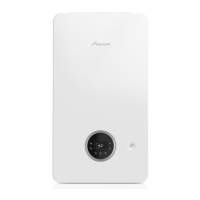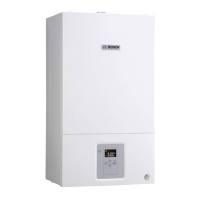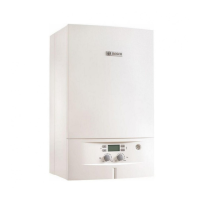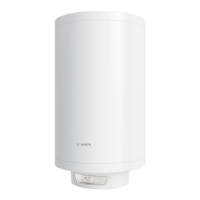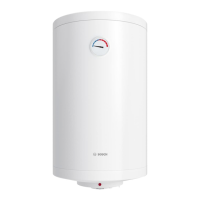6 720 646 812
42
Maintenance and service
5. Disconnect inlet and outlet water pipes from the
water heater. Place a small bucket underneath the
water heater to catch residual water remaining inside
the water heater.
6. Using an air compressor, blow short bursts of air
(100psi max) through the inlet water connection until
there is no water present coming through the outlet
water connection of the heater.
7. Reconnect water fittings and return heater to service
when danger of freezing has passed.
6.3 Mineral scale build-up
Periodic descaling may be necessary in areas with high
mineral content in the water. Scale buildup in the heat
exchanger may result in lower flow rates, error codes of
A7 and E9 and boiling sounds in the heat exchanger.
A water softener is required if the water hardness
exceeds 6 grains/gal (103 mg/l) calcium carbonate.
Damage to the water heater resulting from hard water/
scale deposits will not be covered under warranty.
Descaling using a pump
1. Disconnect electrical supply from the water heater.
2. Shut off the water supply to the water heater using
(installer supplied) shutoff valve.
3. Open hot water taps to drain and relieve pressure
from the plumbing system.
4. Drain water from the unit's heat exchanger by
disconnecting inlet and outlet water connections
from the heater.
5. Connect a line (A) from the outlet of the circulating
pump (installer supplied) to the inlet water fitting on
the water heater (see Fig. 65.)
6. Using another line (B), connect the water outlet
fitting on the water heater. Route the other end of this
line into a descaling reservoir.
7. Using a 3rd line (C) from the descaling reservoir,
connect to the inlet side of circulating pump. Install a
filter on the end of the line in the descaling reservoir.
8. Make sure all connections are "water tight.".
9. Fill tank with descaling solution so both lines inside
are submersed. We recommend a straight white
vinegar solution. If using a commercial descalant,
refer to manufacturer's instructions for proper
dilution ratio.
10.Operate the circulating pump.
11.Make sure there are no leaks and the solution is
flowing from the descaling reservoir through the
heater and returning to the reservoir.
12.Run solution through the heater until the solution
returning to the descaling reservoir comes out clear.
(Changing to a fresh solution may be necessary
during this process).
13.Disconnect all lines and drain all solution from heat
exchanger. Properly discard of solution.
14.Position a container below the hot water outlet and
connect cold water supply. Open cold water supply
shutoff valve and flush heat exchanger with clean
water.
15.Shut cold water shutoff valve and reconnect hot
water supply to the water heater.
16. Reconnect electrical supply to unit, open water
shutoff valves, and return the unit to service.
Fig. 65
6.4 Condensing heat exchanger unit
The condensing heat exchanger unit must be checked
once a year by a qualified and trained technician. If
repairs are needed, the repairs should be done by a cer-
tified Bosch technician.
Fig. 66 Condensing heat exchanger unit
Condensing heat exchanger unit maintenance;
B Shut off power. Disconnect power cord.
B Dismantle all inlet, outlet pipes and the condensate
tube from the condensing heat exchanger unit.
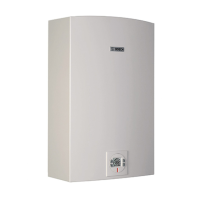
